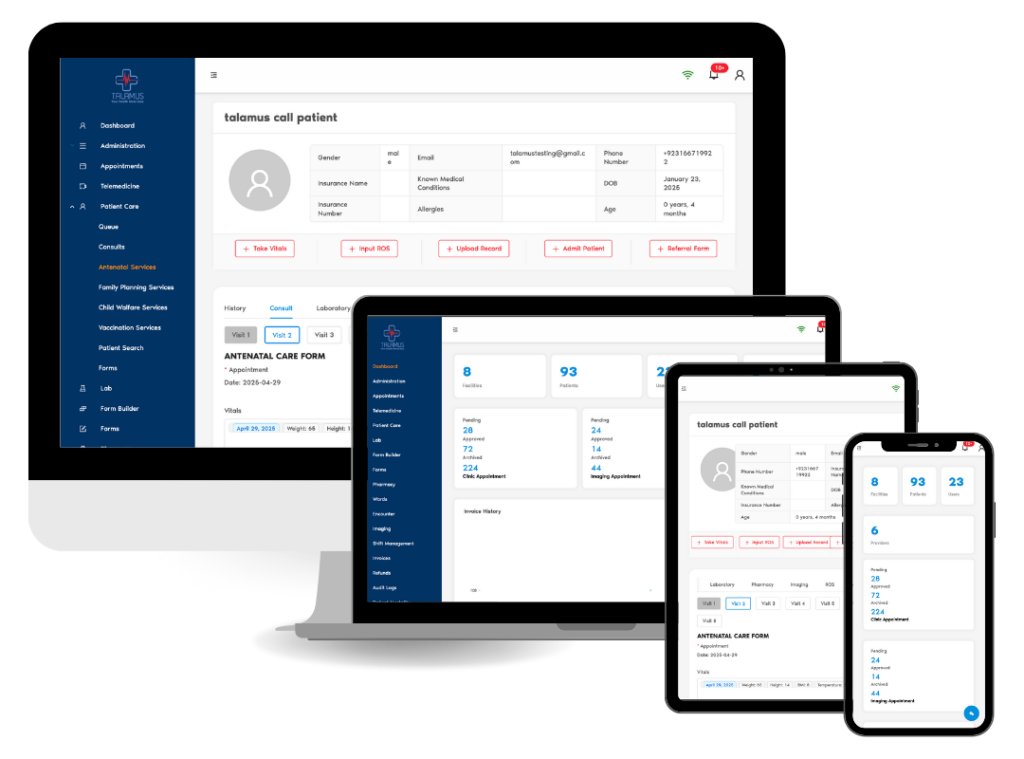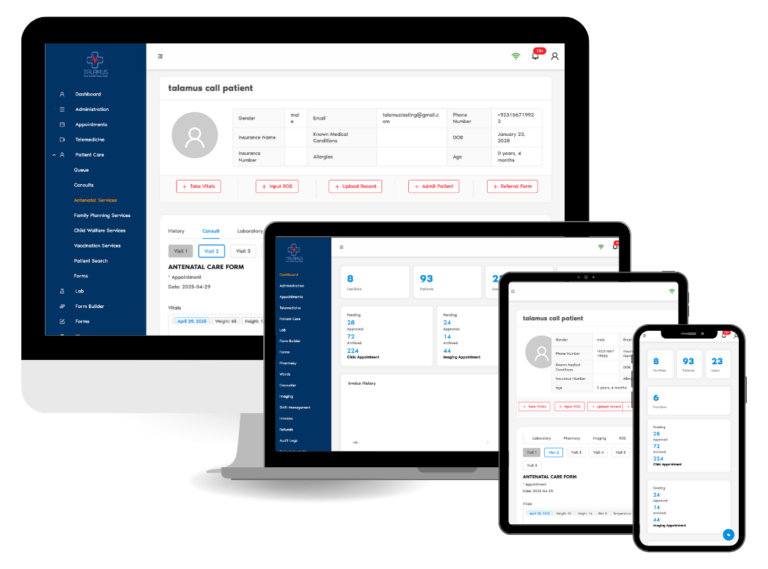Talamus Practice Management App (PMA)
The Talamus Practice Management App (PMA) is a responsive web-based Electronic Health Record (EHR) system designed for healthcare providers — including doctors, nurses, lab personnel, and pharmacists — to efficiently manage patient care. It streamlines hospital operations, reduces patient waiting times, and enhances the overall healthcare experience. The system is live and operational in over 150 facilities within Lagos State’s primary health care network, various private hospitals, and across four African countries.

The Challenge
Healthcare providers often struggle with fragmented systems, manual record-keeping, and time-consuming workflows that increase patient wait times and reduce efficiency. With multiple disconnected tools in use, it becomes difficult to maintain accurate patient records, streamline appointments, and ensure smooth coordination between doctors, nurses, labs, and pharmacies.
The Goal
To design a responsive, interoperable Electronic Health Record (EHR) web app that connects healthcare providers, inventory systems, and patient-facing tools into a single ecosystem. The solution needed to:
Reduce patient waiting time.
Improve workflow efficiency for healthcare staff.
Ensure accessibility across devices (desktop, tablet, and mobile).
Present complex medical data in a clear, usable format.
My Role & Timeline
My Role
- UI Design
- UX Research
Team
- 3 UX Designers
- 1 Product Manager
- 4 Developers
Tools
- Figma
- Slack
- Jira
User Research
Since the web app is used daily by healthcare professionals under time pressure, the focus was on understanding workflow bottlenecks and usability challenges in existing systems.
Conducted contextual research on how providers interact with digital tools in clinical settings.
Studied industry best practices for EHR UI, emphasizing data clarity, accessibility, and compliance.
Incorporated insights from real-world usage of the live system across hospitals to inform design refinements.
Stakeholder Interviews
Collaborated with product managers, clinical advisors, and developers to:
Understand the functional requirements for EHR systems.
Prioritize features critical to primary healthcare centers and private hospitals.
Balance clinical accuracy with ease of use, ensuring the platform works for a wide range of providers (doctors, nurses, lab staff, and pharmacists).
Competitor Analysis
Reviewed existing EHR and practice management systems to benchmark design best practices and identify gaps:
Strengths observed: Clear dashboards, quick access to patient history, modular layouts.
Weaknesses observed: Overly complex navigation, data overload, and poor responsiveness on mobile devices.
These findings guided design decisions to make Talamus PMA more streamlined, responsive, and user-friendly.
Problem Statement
Healthcare providers often face challenges with fragmented systems, manual processes, and time-consuming workflows that lead to longer patient wait times and administrative bottlenecks. The goal was to design an EHR platform that centralizes patient data, streamlines workflows, and supports interoperability between multiple healthcare tools — all while remaining easy to use in high-pressure clinical environments.
Design Process
Industry Research & Benchmarking – Studied best practices in EHR UI design, focusing on accessibility, data clarity, and HIPAA-compliant workflows.
Wireframing & Layout Planning – Created low-fidelity wireframes to map appointment scheduling, patient profiles, lab orders, and inventory management workflows.
High-Fidelity UI Design – Developed a visual system that balances data density with readability, using a consistent design language across modules.
Responsive Design Testing – Ensured seamless experience on desktop stations in hospitals, tablets used during ward rounds, and mobile devices for on-the-go access.
UI Design
Patient Dashboard – Displays key patient information, visit history, and current treatment plans in a single view.
Appointment Scheduling – Simplifies booking, tracking, and rescheduling, reducing administrative workload.
Lab & Pharmacy Integration – Allows direct orders and results tracking within the patient’s record.
Inventory Monitoring – Supports real-time stock level tracking and automated alerts for reordering.

Design Decisions & Impact
Reduced Clicks & Navigation Time – Core workflows were redesigned for faster completion, critical in time-sensitive healthcare environments.
Clear Data Presentation – Information hierarchy ensures vital details are prominent, reducing cognitive load.
Consistency Across Modules – A unified design language makes it easier for staff to move between functions without retraining.
Outcome
The redesigned Talamus PMA has been deployed to over 100 healthcare facilities, contributing to improved efficiency, reduced patient wait times, and better coordination of care. Its interoperable design ensures smooth data exchange between the PMA, inventory system, and patient app — forming a robust healthcare management ecosystem.
Some Screens From the Design
The PMA, inventory management system, and patient-facing app are fully interconnected, creating an interoperable healthcare ecosystem that supports seamless data exchange between providers and patients.
